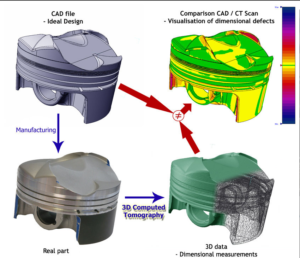In many cases, manufacturing methods, such as punched parts, injection molded, or investment cast parts, indicate Mechanical Parts Dimensional Analysis in PC Board Reverse Engineering.
(1) Normally, items that are sheared or punched do not require a good surface finish on the sheared edge. However, in some cases, the manufacturer will intentionally punch a hole with a minimum clearance between the punch and the die. This is done to create a larger “straight land” in the hole, which may be required as a load bearing surface or to minimize wear on mating parts. When reverse engineering a punched hole, the “land-width” should be noted. If it is more than 25% of the length of the hole, it could be intentional.

Mechanical Parts Dimensional Analysis in PC Board Reverse Engineering
(2) In addition to the draft and parting lines, ejection-pin locations should be included in the final drawing.
Joining methods such as riveting or spot-welding may require testing to determine the strength requirements. Many spot-welded items are controlled at the weld by pull-tests. If necessary, applicable specifications should be reviewed for inclusion in the final TDP.
Heat treatment should be evaluated, using cross sections as required to determine case depth, grain structure and other metallurgical requirements. Grain flow on forgings should be noted.
Whenever a pressed-in bushing exists, concentricity of that bushing to the diameter securing it should be ensured.
If dowel pins are used to align mating parts, the location of the pins at the projected distance should be ensured to assure the fit of those parts.
Surface finishes on all mating surfaces should be checked, whether or not a gasket is used. Casting surfaces subject to wear for grain structure variances caused by special casting processes should be examined using chills to “harden” the casting in that particular area. Electrical wire diameters should be measured and insulation type and thickness noted. The length of the wire should be duplicated even if it appears to be excessive. Shortening a wire length could change the electrical characteristics of the end item.






